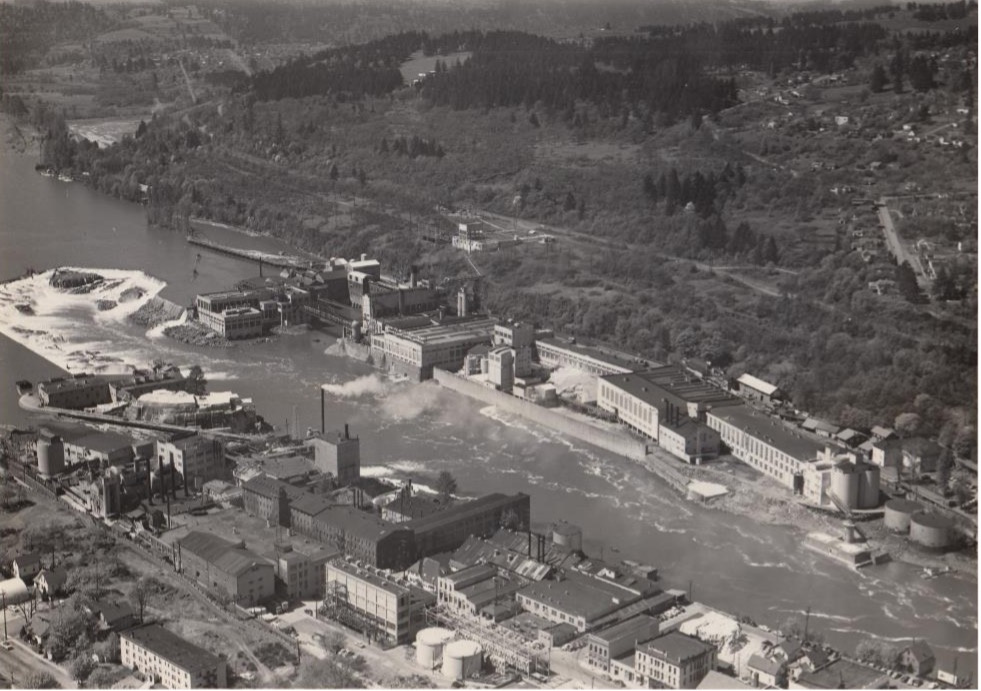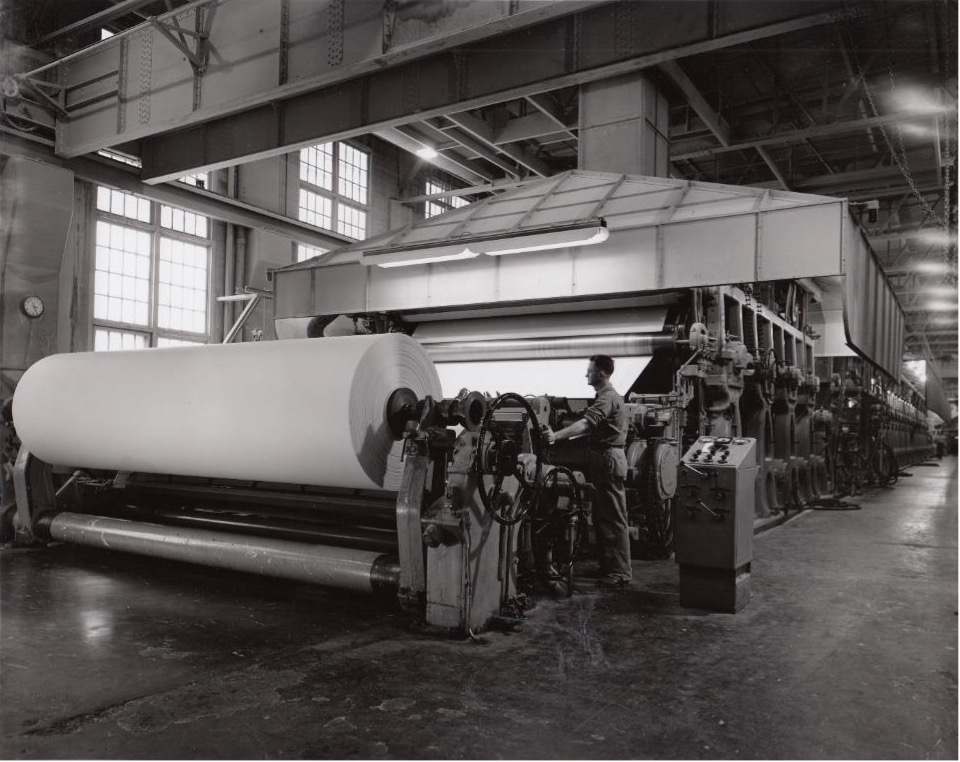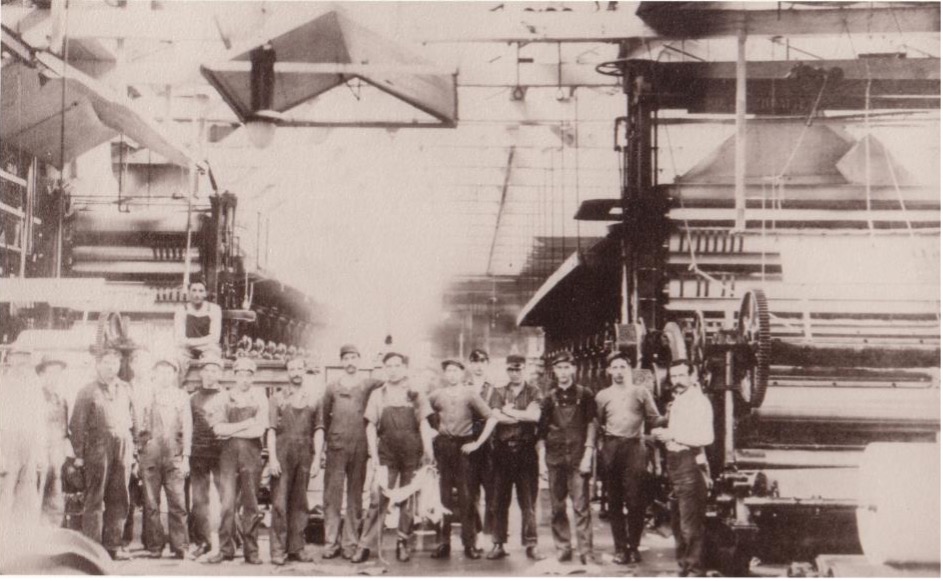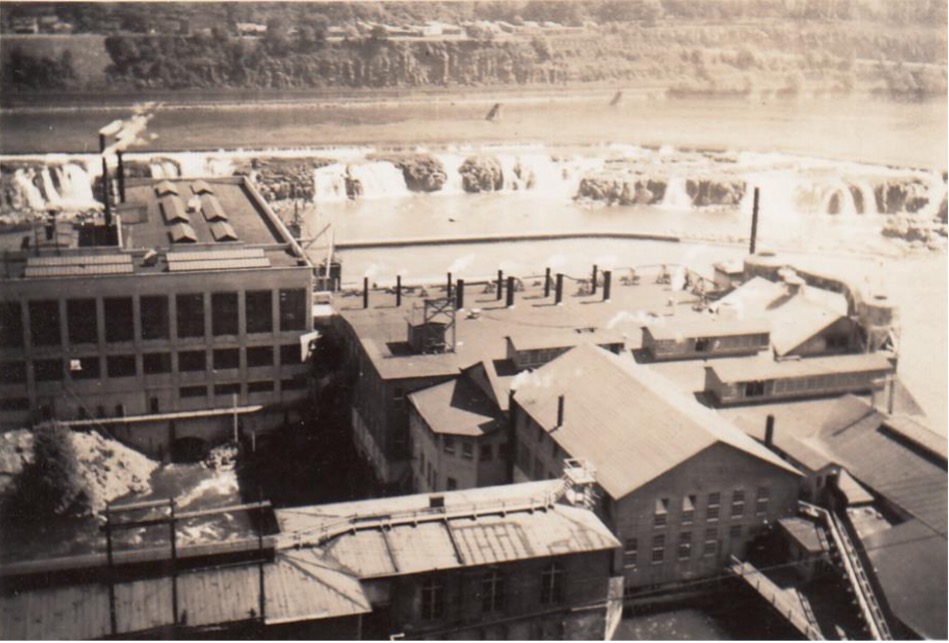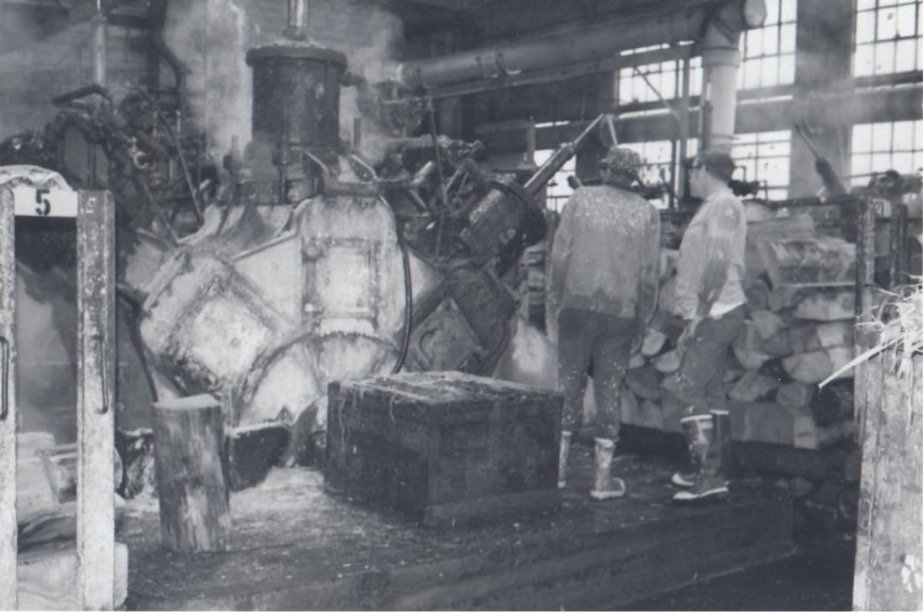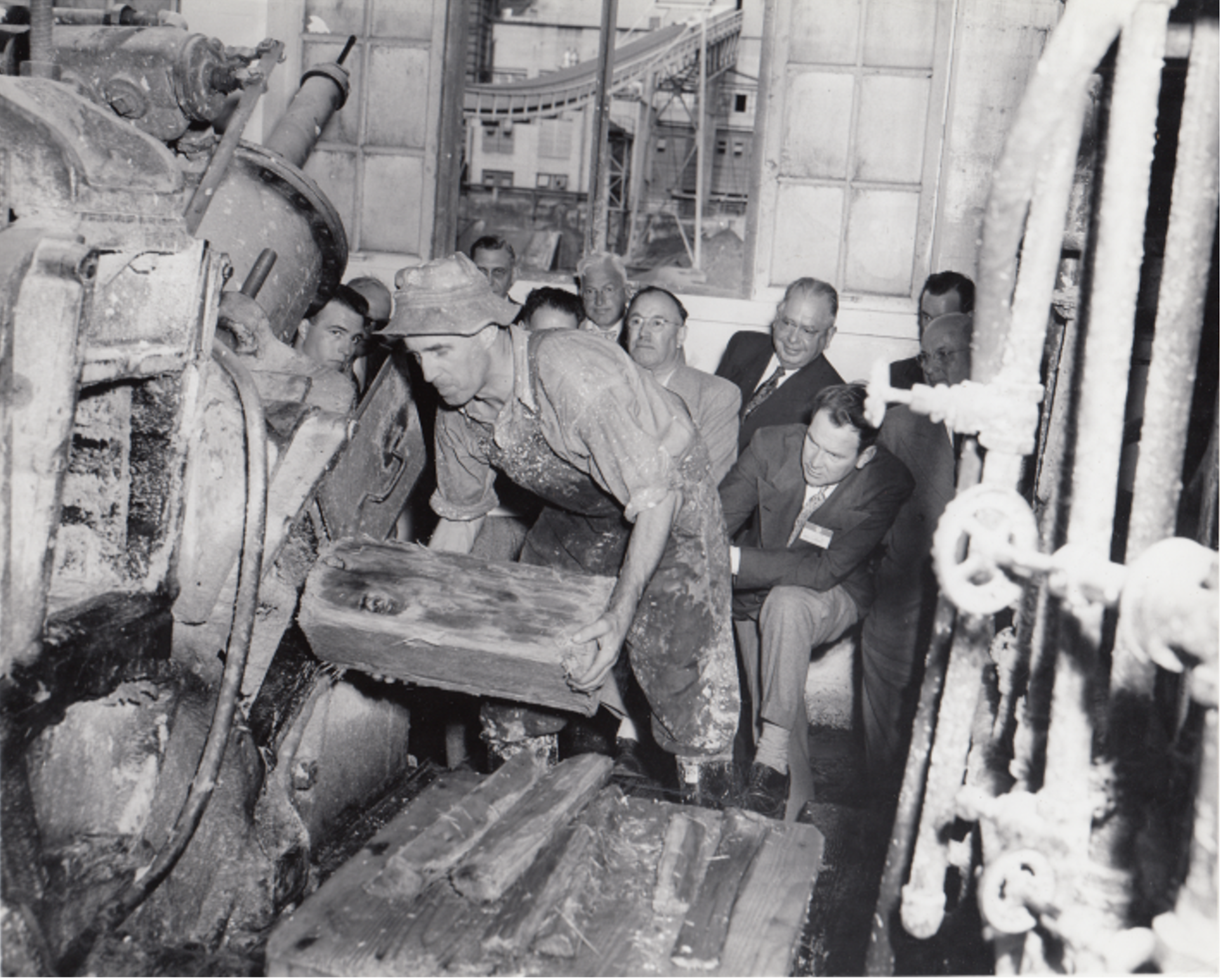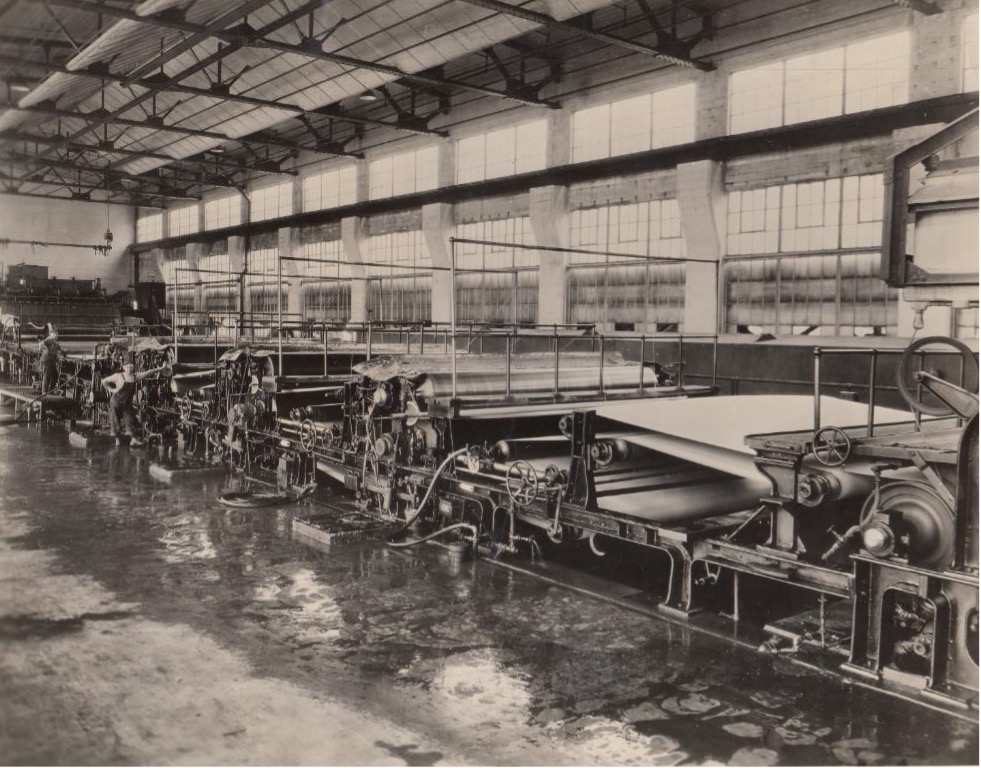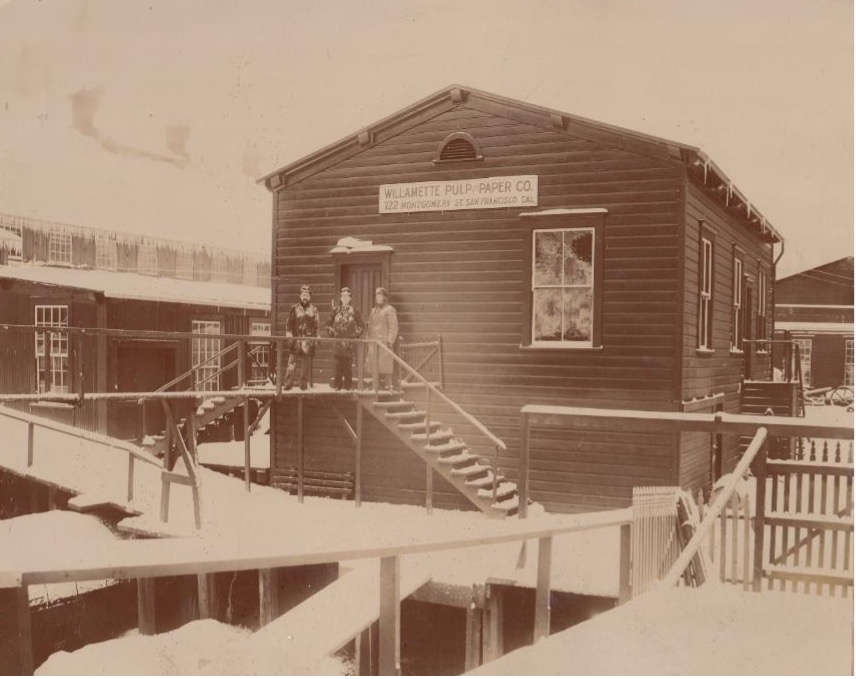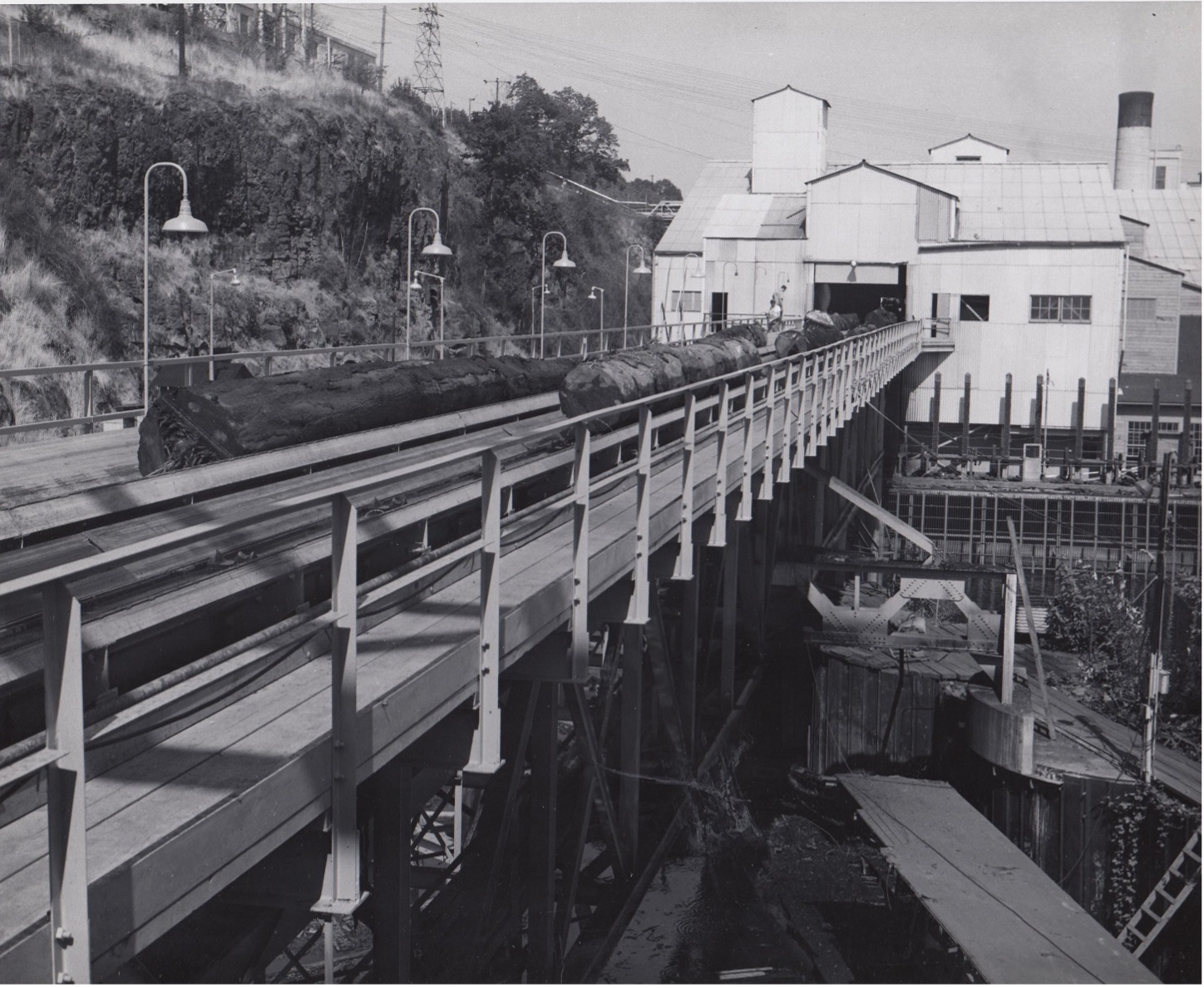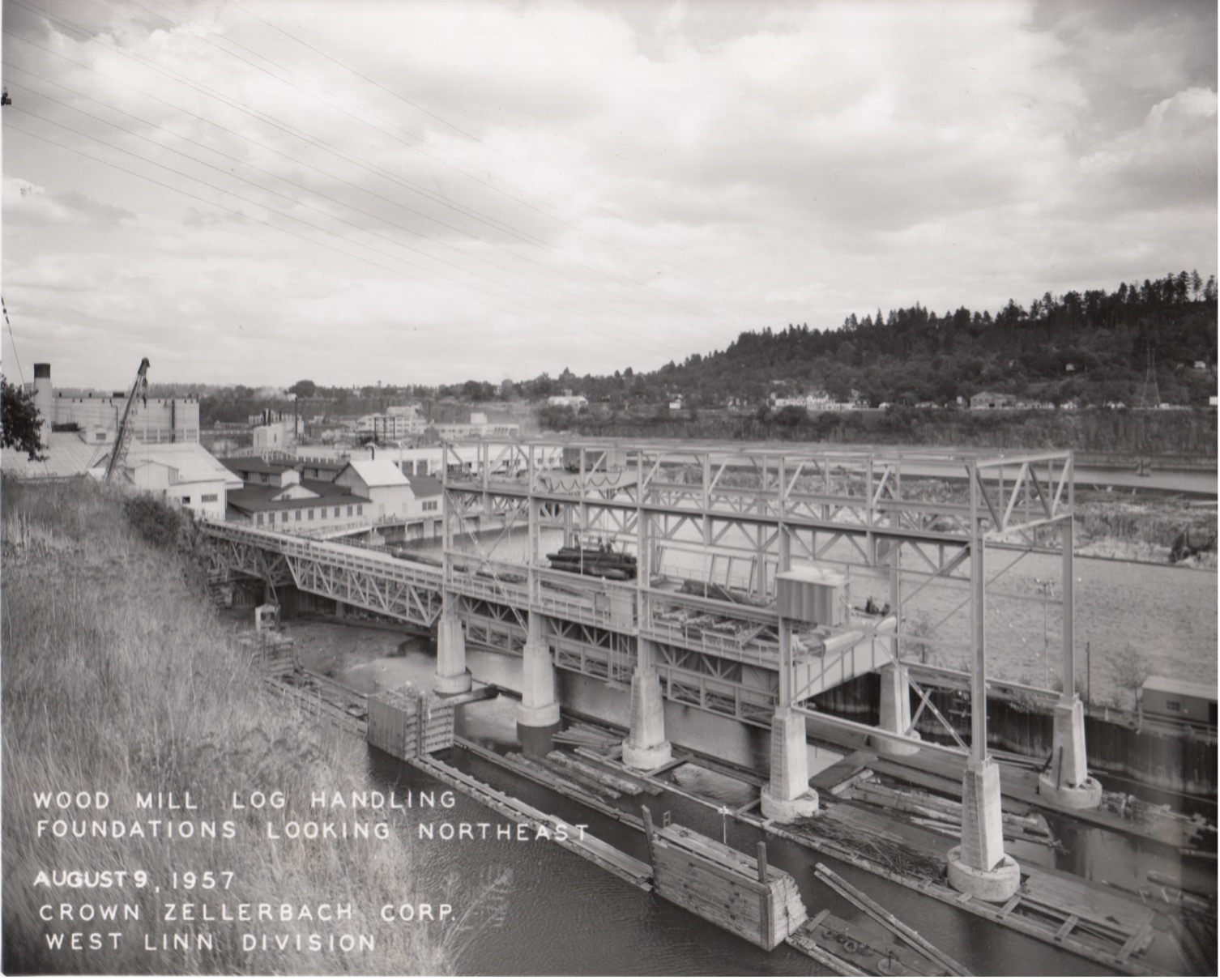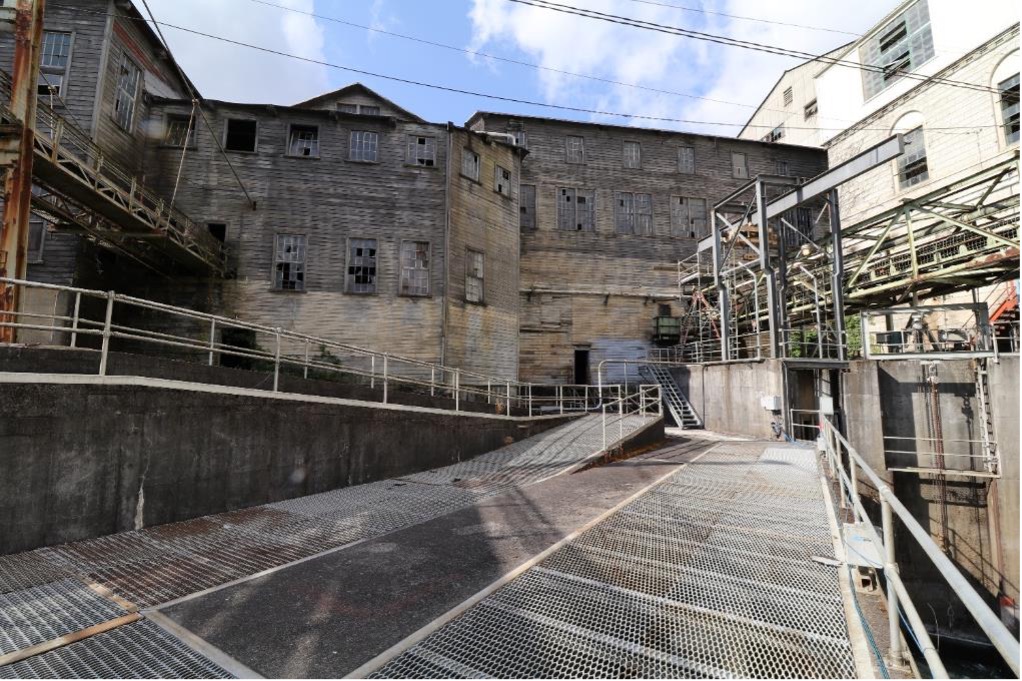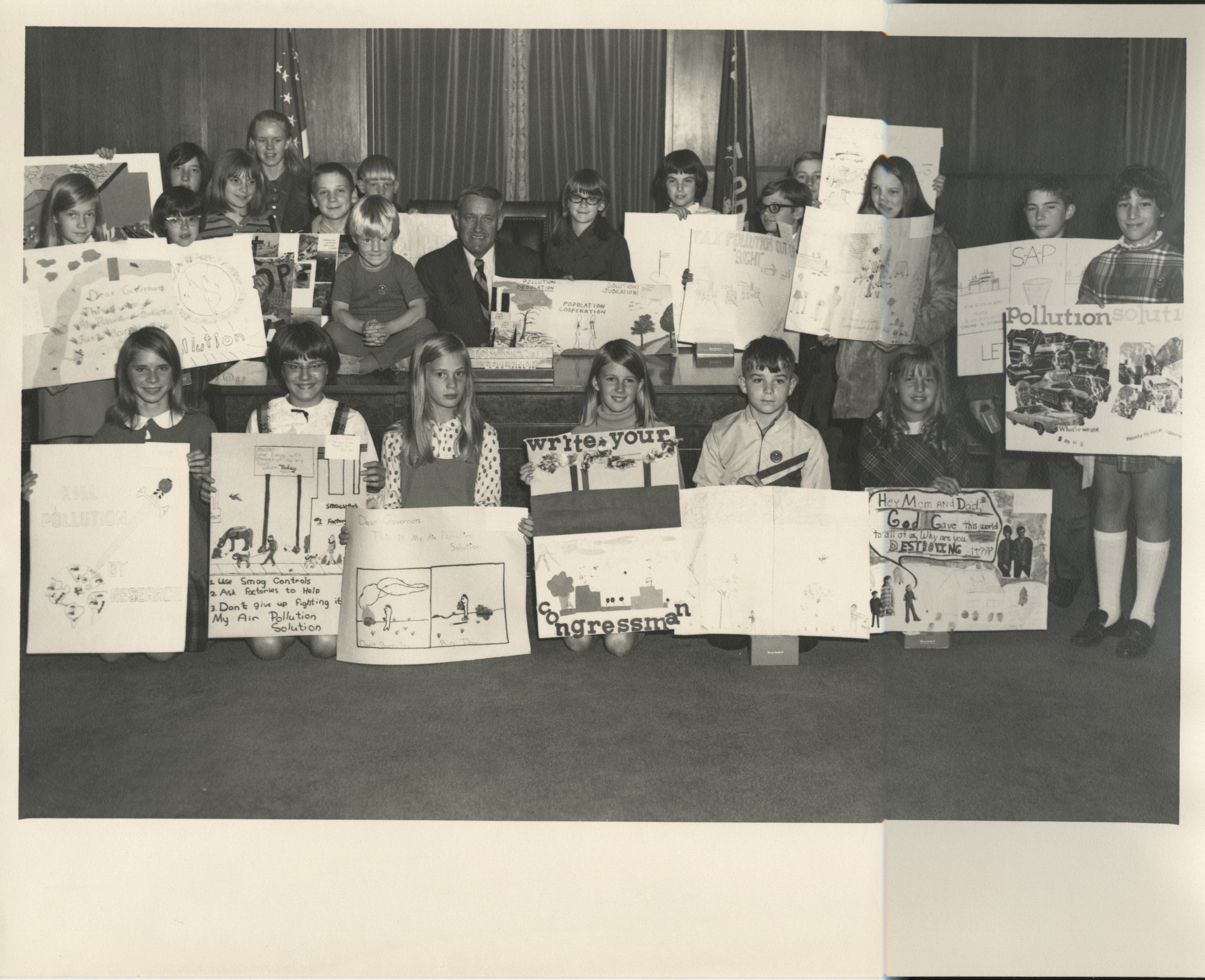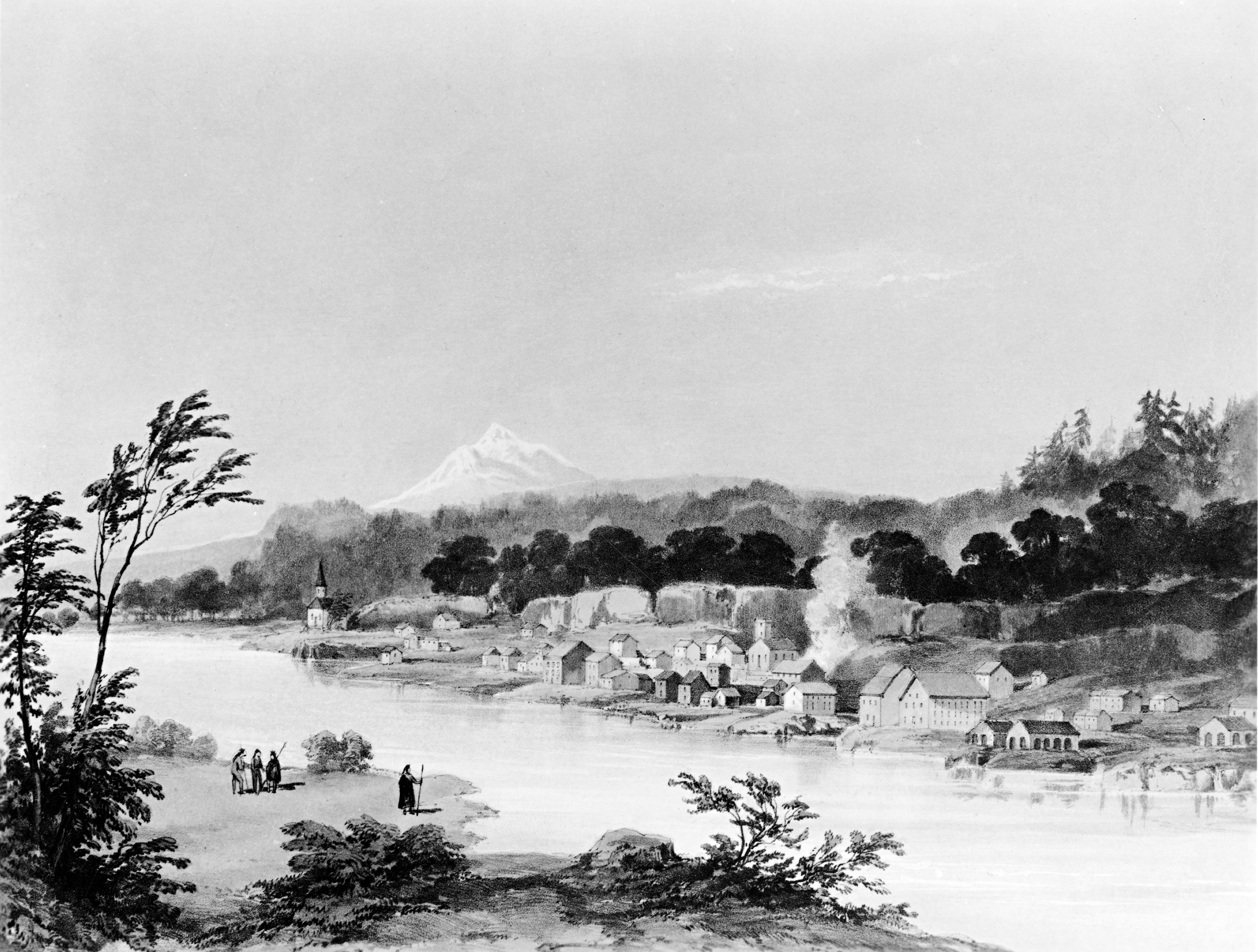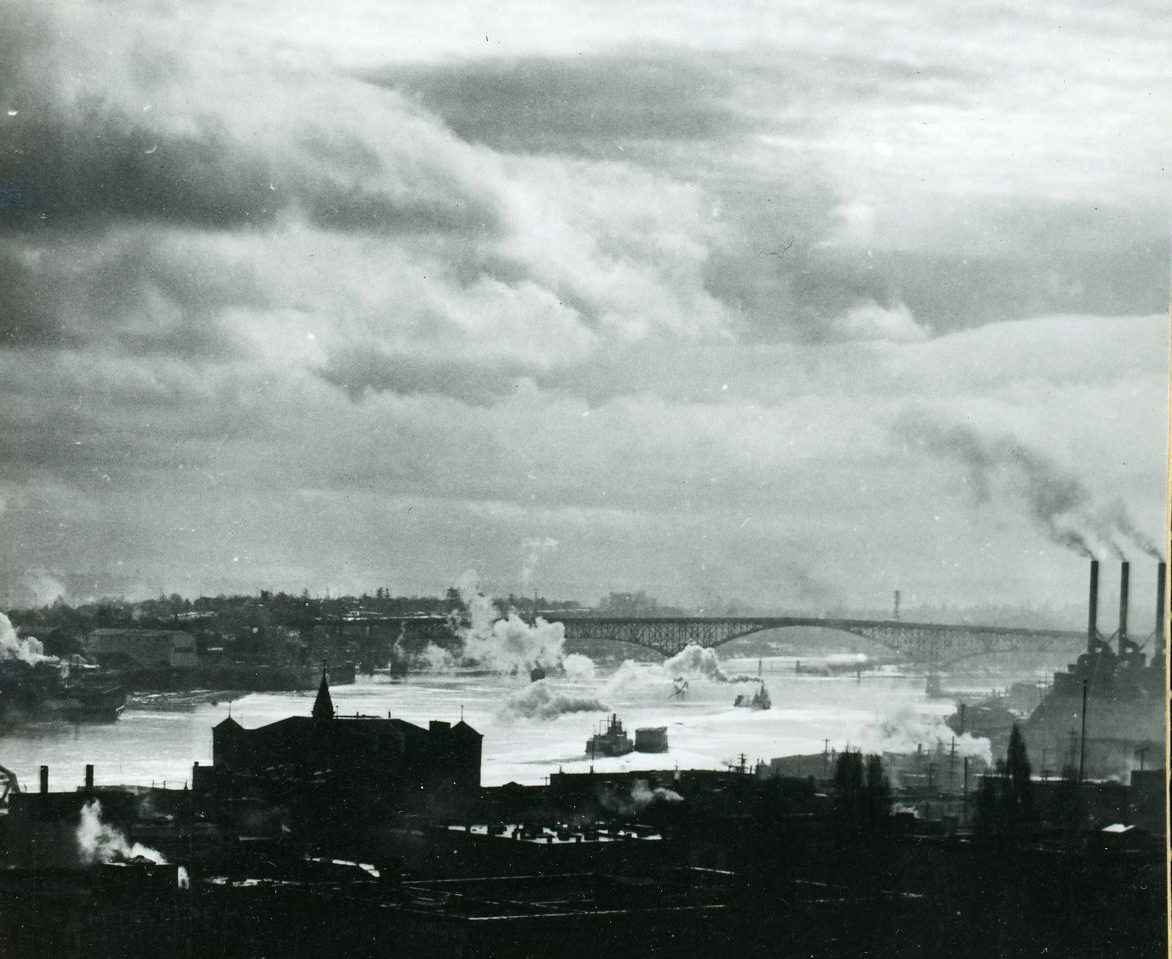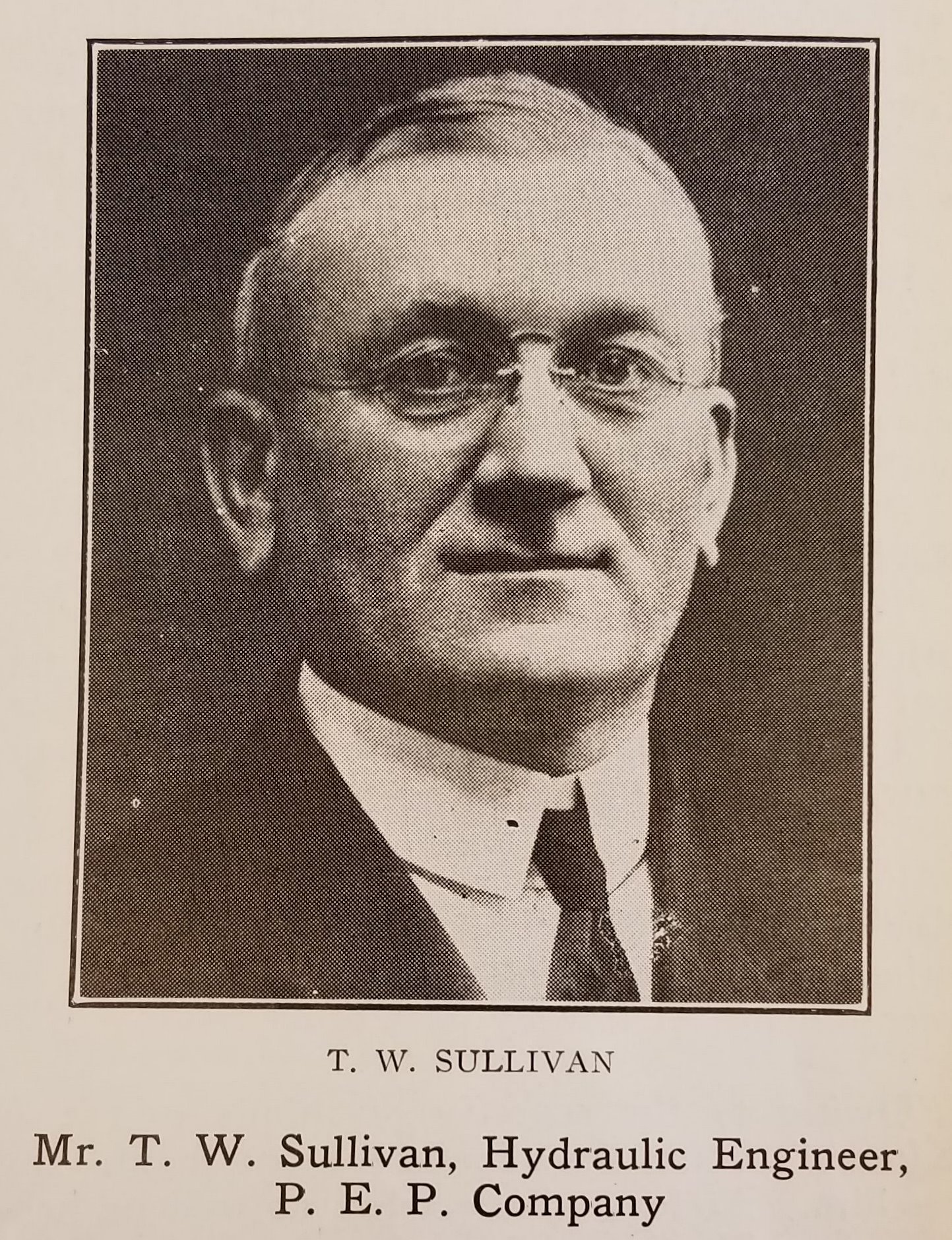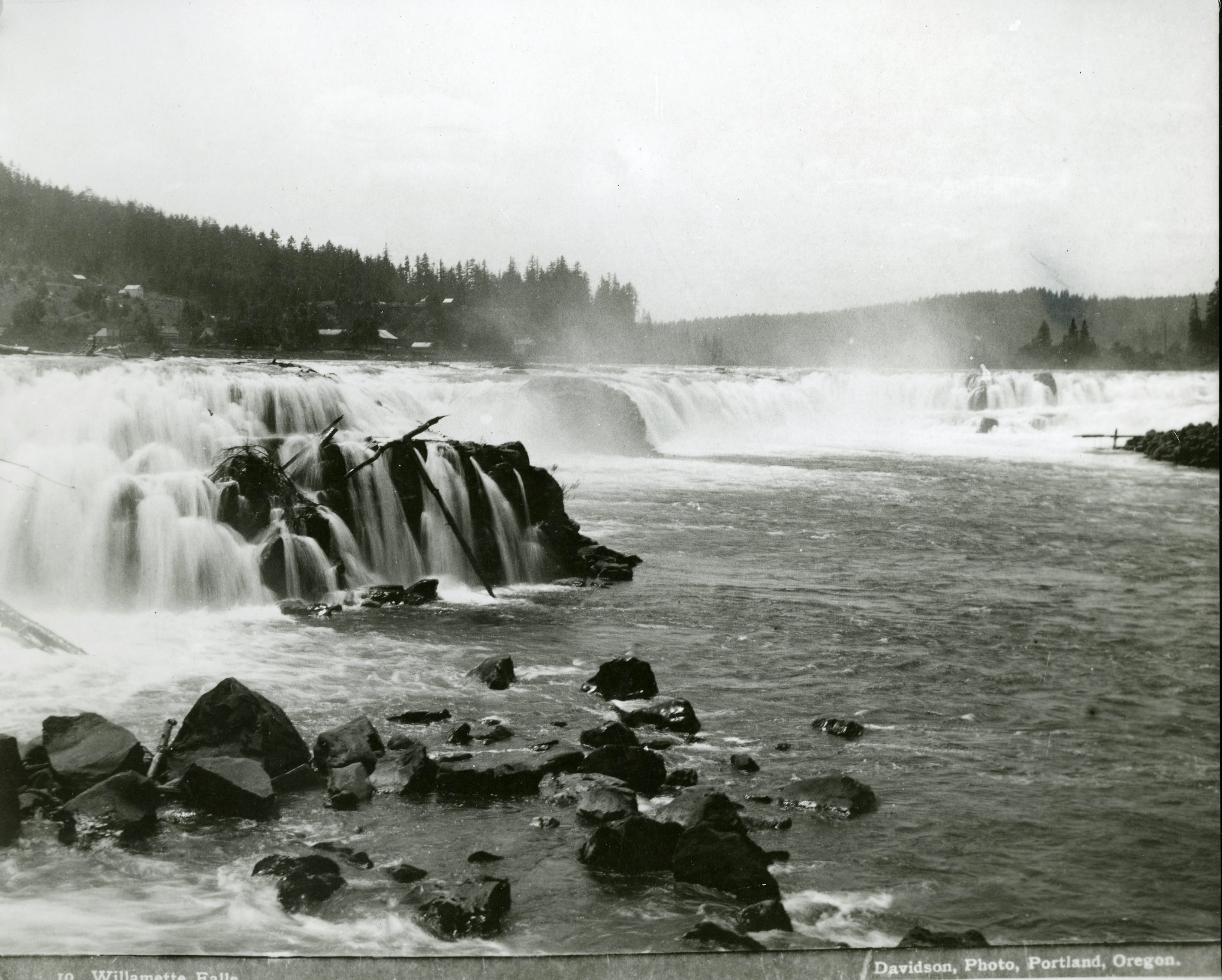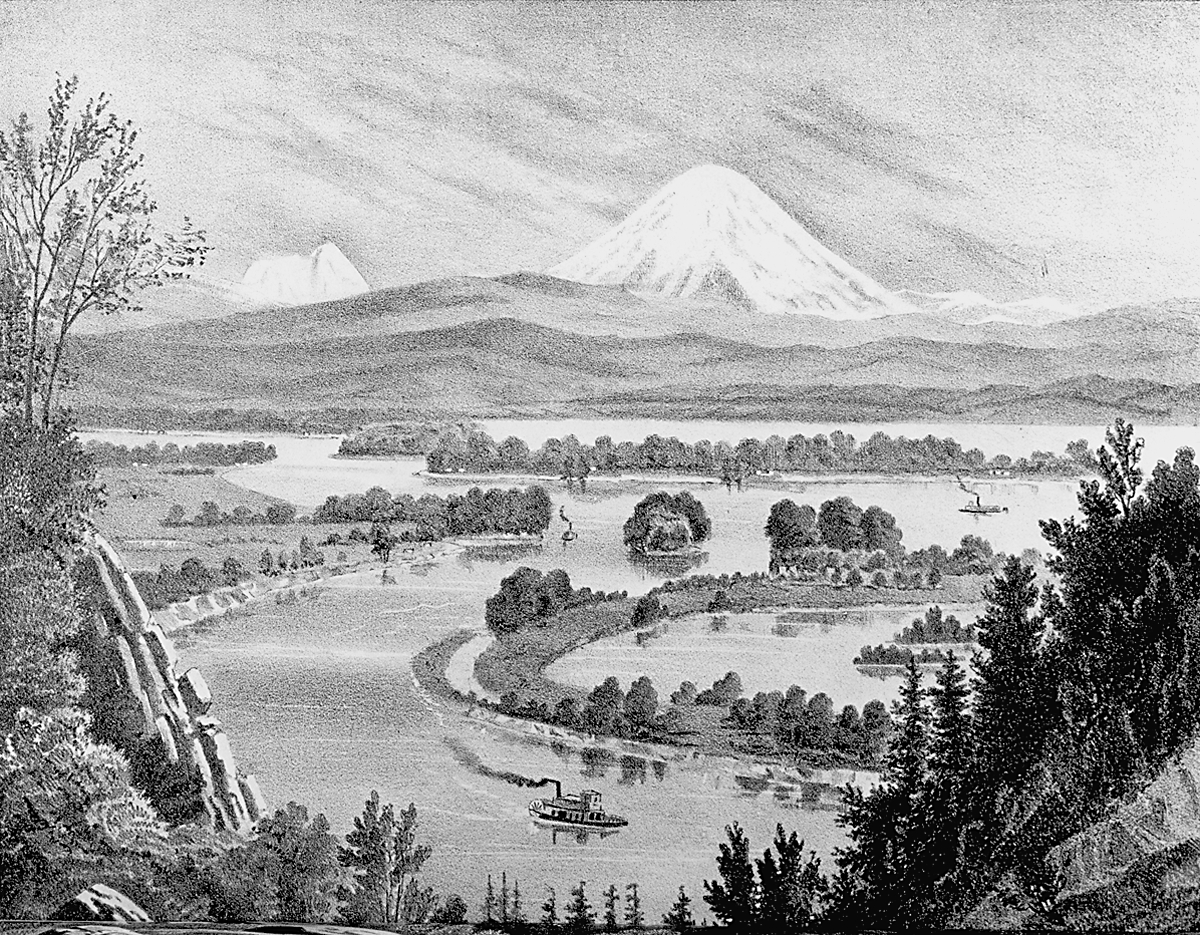From Oregon’s earliest settlement, the effort to harness the power of the Willamette Falls for industrial purposes has played a role in the development of the state. In October 1866, the Oregon City Paper Manufacturing Company (also referred to as the Pioneer Paper Manufacturing Company) established a mill on the east bank of the Willamette to process wood into pulp and make paper, but that operation ended in debt within a year. Despite the company’s failure, the waterpower of the falls and the plentiful trees from nearby forests were an irresistible combination for papermaking.
In 1888, California and New York investors—funded by the influential Remington family, pioneer paper manufacturers from New York—built a pulp mill in what is now West Linn, on the west side of the Willamette River, and named it the Willamette Falls Pulp and Paper Company. Illustrious Remington (1790–1883) and his three sons established a paper mill in Watertown, New York, in 1869, and within a year they were operating four mills there, providing newsprint for the New York Times. The family built other mills in the northeast, including the first sulfite mill in the United States (in Watertown).
Willamette Falls Pulp and Paper’s first plant, Mill A, began operations in October 1889. Workers ground trees into pulp using waterpower from the falls and then shipped the raw pulp to a Remington-owned paper mill in Stockton, California, where it was made into paper. Willamette Falls Pulp and Paper soon added paper machines at the mill in West Linn, saving the company shipping cost and time.
At the same time, the company built Mill B, the first sulfite mill west of the Mississippi River (also called a sulphite mill or digester). The mill was designed by Thomas W. Sullivan, a young engineer from the Remington plant in Watertown who had designed their sulfite mill. Sulfite mills use chemicals to “digest” wood pulp into a fiber slurry rather than grinding it into pulp with large abrasive wheels. Sulfite-processed pulp had finer, more consistent fibers and yielded a higher grade of paper. In 1895, Sullivan also designed a hydroelectric power plant, now known as Station B, at West Linn, which was renamed in his honor in 1953 and as of 2024 was still in operation.
Papermaking at Willamette Falls began by logging trees, typically cottonwood, and floating them downriver to Mill A in log rafts. Individual logs were transferred to the log haul, a conveyor that moved logs into the sawmill, where a multiblade gang saw cut them into short sections called chocks. De-barked chocks were then sent either to the Mill A grinder room, where large water-powered (later electric-powered) rotating wheels of abrasive stones ground them into pulp, or to the Mill B digester, where a chemical process did the same thing. From there, the pulp—that is, the watery wood-fiber packed slurry—was sent to a machine that processed and pressed it into paper.
In November 1889, the Crown Paper Company built a paper mill at West Linn adjacent to the Willamette Falls Pulp and Paper Company operation, and Willamette Falls became an increasingly important paper manufacturing center. In 1908, Willard P. Hawley, who had come to Oregon as part of the Remingtons’ investment and served as the president of Willamette Pulp and Paper, purchased water rights and land across the river in Oregon City, where he opened his own operation, the Hawley Pulp and Paper Company.
West Linn’s Crown and Willamette paper companies merged in 1914, forming the Crown-Willamette Pulp and Paper Company. By World War I, Crown-Willamette was producing toweling, wrapping, and other paper that supplied newsprint to major daily newspapers from Seattle to Los Angeles. At its peak, the Crown-Willamette plant operated ten paper machines, each manufacturing a different grade of paper. Between 1905 and 1920, Mill A was rebuilt and expanded with additional grinder rooms and improved equipment.
The Zellerbach Corporation, a pioneer paper manufacturer based in San Francisco, purchased the Crown-Willamette Company in 1928, and the company was reorganized under the name Crown Zellerbach Corporation. By the 1940s and 1950s Crown Zellerbach was among Oregon’s single largest employers, with about 1,500 workers operating in shifts around-the-clock.
In 1947, Crown Zellerbach employees at Willamette Falls developed a method that used clay and carbonate to create what is known as “coated paper.” The process produced a shiny surface and helped make possible high-quality glossy images in modern magazines. Coated paper was a major breakthrough, and the West Linn paper mill shipped the paper to printers throughout the country, boosting its reputation and position in national paper manufacturing. “When the readers in the western part of the United States, Honolulu, Alaska or Japan pick up their copies of Time and Life magazine,” historian William Welsh wrote, “they hold in their hands a product of the West Linn papermill.”
In 1986, Crown Zellerbach was acquired in a hostile takeover by the James River Corporation, and all ground-wood operations in West Linn ended in 1990. Mill A’s pulp grinders were turned off, some with partially ground chocks still in the machines. The same year, James River sold its West Linn mill to Simpson Paper. The mill was closed in 1996 and reopened the next year under new ownership as the West Linn Paper Company. That company closed in October 2017 and reopened as the Willamette Falls Paper Company in November 2019.
For nearly four decades, the Mill A Complex was essentially vacant. In 2022, due to structural and environmental concerns—specifically with the sawmill, the central area, and Grinder Room 2—the decision was made to remove the superstructures above the concrete foundation, which serves as the dam for the T. W. Sullivan Hydroelectric Plant. Though much reduced in scale and improved by automation, the paper mill at West Linn remains in operation, continuing the long history of papermaking at Willamette Falls.
-
![]()
Aerial view, Willamette Falls Paper Mills, 1955.
Courtesy Willamette Falls/West Linn Paper Company Archive, Image B.0027
-
![]()
Crown-Zellerbach, Paper Machine No.4 in operation, 1960.
Courtesy Willamette Falls/West Linn Paper Company Archive, Image B.0052
-
![]()
Crown-Willamette Workers and Paper Mills, c.1910.
Courtesy Willamette Falls/West Linn Paper Company Archive, Image B.0032
-
![]()
Mill A, Willamette Falls, Grinder Room A, Station B (Sullivan) Powerhouse, 1925.
Courtesy Willamette Falls/West Linn Paper Company Archive, Image A.0036
-
![]()
Mill A Grinder Room workers, 1980.
Courtesy Willamette Falls/West Linn Paper Company Archive, Image B.0004
-
![]()
Loading the grinder, Mill A Grinder Room, 1980.
Courtesy Willamette Falls/West Linn Paper Company Archive, Image B.0014
-
![]()
West Linn Paper Mills, from Oregon City, 1906.
Courtesy Willamette Falls/West Linn Paper Company Archive, Image A0014
-
![It has 154” wire trim and produces between 95 and 100 tons of paper each 24 hours.]()
Bagley and Sweall Fourdriner newsprint paper machine.
It has 154” wire trim and produces between 95 and 100 tons of paper each 24 hours. Courtesy Willamette Falls/West Linn Paper Company Archive, Image B.0024
-
![]()
Willamette Pulp & Paper Company Offices, c.1900.
Courtesy Willamette Falls/West Linn Paper Company Archive, Image A.0116
-
![]()
Wood Mill Log Haul, August 1960.
Courtesy Willamette Falls/West Linn Paper Company Archive, Image B.0013
-
![]()
Wood Mill Log Haul, August 1957.
Courtesy Willamette Falls/West Linn Paper Company Archive, Image A.Loghaul.0035
-
![]()
Mill A, exterior view, 2023.
Courtesy Kenny Gunn, PGE Image
Related Entries
-
![Department of Environmental Quality]()
Department of Environmental Quality
The Oregon Department of Environmental Quality (DEQ) administers and en…
-
![Oregon City]()
Oregon City
Oregon City was the first incorporated city west of the Rocky Mountains…
-
![Pollution in Paradise (documentary film)]()
Pollution in Paradise (documentary film)
KGW-TV aired Tom McCall’s one-hour documentary Pollution in Paradise on…
-
![Thomas W. Sullivan (1863-1940)]()
Thomas W. Sullivan (1863-1940)
Thomas William Sullivan was a hydro engineer who, over a span of half a…
-
![Willamette Falls]()
Willamette Falls
The largest falls in Oregon and the sixth in the United States by volum…
-
Willamette River
The Willamette River and its extensive drainage basin lie in the greate…
Related Historical Records
Map This on the Oregon History WayFinder
The Oregon History Wayfinder is an interactive map that identifies significant places, people, and events in Oregon history.
Further Reading
Adams, W. Claude. History of Papermaking in the Pacific Northwest. Portland, Ore.: Binfords & Mort, Publishers, 1951.
Carter, Sandra Hickson. "$1.09 an Hour and Glad to Have it..." Willamette Falls Heritage Foundation (2011).
Welsh, William D. A Brief History of Oregon City and West Linn. West Linn, Ore: Crown Zellerbach Corp., 1950. Reprint, Literary Licensing, 2012.
Kramer, George. An Oregon Powerhouse: The T. W. Sullivan Story. Portland, Ore: Portland General Electric, 2017.
Stein, Harry H. "The Paper Mill at West Linn, Oregon, 1889-1997: Hydropower, Sawmill and Grinder Operations." Portland, Ore: Jacobs-Sirrine Engineers (A Report for Simpson Paper Company), April 1997.

